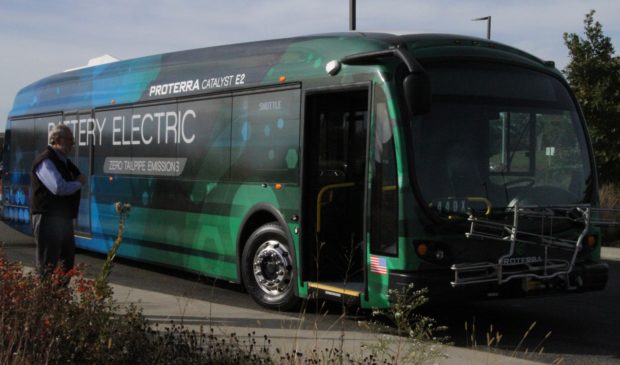Capital Metro eyes a zero-emissions future
Tuesday, August 7, 2018 by
Ryan Young The Capital Metropolitan Transportation Authority is getting ready to bring electric buses to Austin. But they still have a lot of details to work out.
At the agency’s July 30 board meeting, Dottie Watkins, vice president of bus operations, discussed some of the first steps the agency is taking on the road to a zero-emissions fleet.
“This really is the most exciting technology that us bus geeks have faced in a long time,” she said. “The industry as a whole has looked at battery-electric buses. We’ve been monitoring the technology for about 10 years, and folks are saying, okay, I think the technology is about ready.”
Watkins said Capital Metro is planning to purchase 40 electric buses between 2022 and 2024, as part of phase one of the fleet’s electrification. Still unknown: which models of buses, and what their capabilities will be.
Watkins said that current electric buses can go between 120 and 150 miles on a single charge, which is about 25-30 percent of what Capital Metro’s buses drive each day. She was “fairly confident” that by 2022, battery technology will have progressed to the point where electric buses can cover 50 percent of what Capital Metro needs.
By waiting until 2022, Capital Metro is actually being pretty conservative – Watkins said that nationwide, only about 1-2 percent of buses are electric, but 10 percent of the new buses on order are electric models. And now, New York City and Los Angeles, the cities with the largest bus systems, have electric buses on order.
“We didn’t want to get in too early because there’s going to be a point at which once I get in, I’m going to keep that bus for 12-14 years,” Watkins said. “I don’t want to overly constrain my fleet to smaller battery ranges.”
And this August and September, Capital Metro plans to demo electric buses from Proterra, New Flyer and Chinese manufacturer Build Your Dreams. “We also want to see what an electric bus can do in the summer heat,” Watkins explained, because the use of air conditioning in Central Texas’ notorious heat could reduce the range of electric buses even further.
Still, Capital Metro anticipates a full rollout of electric buses as opposed to a limited testing program. “We decided that the industry has done enough pilot projects that we didn’t need to do a pilot project of our own,” Watkins said.
Infrastructure is another big unknown. Going electric isn’t just a matter of buying the buses – it also requires charging stations and electrical upgrades, such as new transformers and switching yards, to handle such massive loads. “Buying a bus with diesel is: You’ve got fuel in the ground, you buy buses, you fill them up, you move,” said Capital Metro CEO Randy Clarke. “Electric is a holistic approach to how we’re managing the fleet and infrastructure together.”
Although electric buses are still several years away, Capital Metro is already thinking about these infrastructure issues. Watkins said the agency is coordinating with Austin Energy to determine what kinds of investments they will need to make in the grid. And next year, when Capital Metro expands its North Operations facility near Burnet Road by demolishing a derelict mattress factory, they will reserve space for 48 electric buses and their charging pads.
Then there’s the financial uncertainty. Watkins said that while an electric bus would theoretically have lower operating costs compared to a diesel bus, electric currently comes at a $300,000 premium over diesel – and no transit agency has used electric buses long enough to determine if they can pay for themselves. (A New York City study found that electrics might cost slightly less than their diesel counterparts over a 12-year life span.)
To navigate all of this, Capital Metro is turning to outside expertise. The agency is consulting with the Center for Transportation and the Environment to build a proper road map for the electric transition. And this year, Capital Metro also joined the Zero Emission Bus Resource Alliance to share data and lessons learned about operating electric buses.
“We have 423 buses in our fleet. How do we go from 40 to 80 to 100 to 400?” Watkins said. “That’s really something that is beyond the expertise we have in-house that we’re going to ask the experts to help us map out.”
Finally, Clarke hinted at a possible role for electric buses in Project Connect, Capital Metro’s ongoing high-capacity transit study. “We do Project Connect a certain way,” he posited, “we’ll probably have a lot more electric facilities and needs.”
Photo by Jonathunder – Own work, GFDL 1.2, Link.
The Austin Monitor’s work is made possible by donations from the community. Though our reporting covers donors from time to time, we are careful to keep business and editorial efforts separate while maintaining transparency. A complete list of donors is available here, and our code of ethics is explained here.
You're a community leader
And we’re honored you look to us for serious, in-depth news. You know a strong community needs local and dedicated watchdog reporting. We’re here for you and that won’t change. Now will you take the powerful next step and support our nonprofit news organization?



